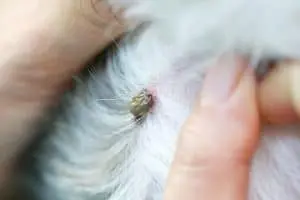You and your pet will want to spend more time outdoors during the warmer weather. But if Fido plays in a field, the woods, or even your backyard, he may pick up a tick or two in the process. These parasitic pests can carry deadly diseases, so it’s important to check him over to make sure he is not bringing a freeloader inside on his fur. If a tick does take hold of your pet, there is a safe way to remove it and avoid a trip to the vet.
Tips on Checking for Ticks
When your pet is spending much of the day outdoors, you’ll need to give him regular exams to make sure he hasn’t befriended some ticks. Here are some tips to help.
First, it’s important to be able to identify these tiny parasites. Ticks are arachnids, like spiders, so they have eight legs. Many types of ticks are barely even the size of a pinhead. And it’s not just their size that makes them difficult to find—these tiny pests can be brown, black, or tan in color, blending in easily with fur. The deer tick, also known as the black-legged tick, is a dangerous species because it is a carrier of the bacteria that causes Lyme disease. These ticks are brown to brownish red in color and have a flattened appearance.
Now that you know what to look for, it’s time to get up close and personal with your pet. Make sure your dog—or cat—is calm and still. It’s helpful to have a second person holding your four-legged friend in place. Once you get your pet to stay put, run your hands slowly over the fur feeling for any bumps or swollen areas. Make sure to hit the high traffic areas that ticks like most—the underbelly, behind and around ears, and between the toes.
Tools for Taking Care of Ticks
When getting ready to remove a tick from your pet, it’s important to have on hand everything you need.
- Gloves
- Tweezers with a pointed tip (or a tick removing tool)
- Rubbing alcohol
- Lidded container
- Antiseptic wipes
How to Safely Remove a Tick from Your Pet
It’s important to act quickly when you find a freeloader in Fido’s fur because there’s a very small chance you can get to the tick before it embeds itself in your pet’s skin. If it’s already embedded, here are the steps to take that tick out.
- Wear gloves so you are not the tick’s next victim.
- Clean the tick and area around it with alcohol.
- Use pointed tweezers (or a tick remover tool) and grab onto the tick’s body as close to the pet’s skin as possible. (Careful not to pinch your pup!)
- Take the tick out with a straight, firm, and slow pull, but be careful not to squeeze its body. If you pull too fast, you risk leaving the tick’s head embedded in the skin, and that will require a trip to the vet. Once the tick is out, make sure you have the whole thing—head and all.
- Place the removed tick in a lidded jar or container of alcohol to kill it. Ticks are notoriously hard to kill and if not done properly you may find that it’s returned to the scene of the crime. Dropping it in alcohol will do the job. Keep the container on hand for a few days—if your dog shows signs or symptoms of illness, you can take the tick to have it properly identified and tested for disease.
- Clean the area vacated by the tick with an antiseptic, and be sure to sterilize the tweezer or tool you used as well.
- Keep a close eye on your pet for a few weeks after the removal. Symptoms such as lethargy, loss of appetite, or fever can be signs that the tick passed on a problem to your pooch. And check the area where the tick was for infection.
To find out more on how to keep your yard, family, and pets free of ticks, contact Free Spray Lawn Care today at 419-529-5296.



Comments (0)
Thanks for your comment!
Thanks for your feedback! Your comments have been successfully submitted! Please note, all comments require admin approval prior to display.
Error submitting comment!
There is a problem with your comment, please see below and try again.